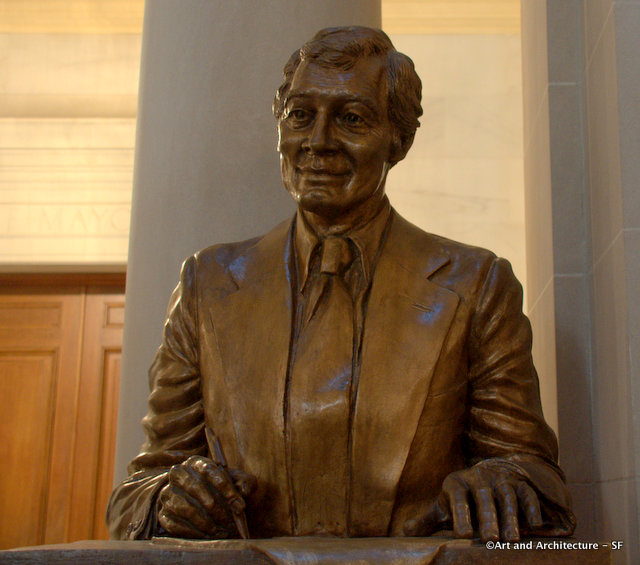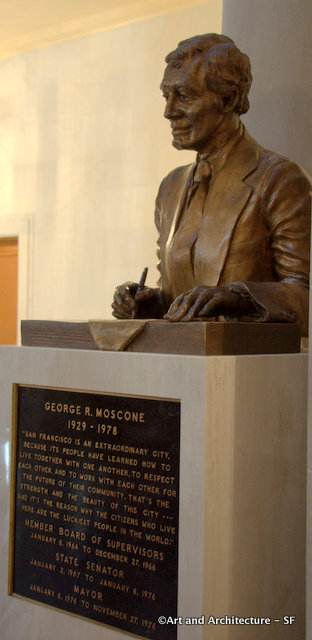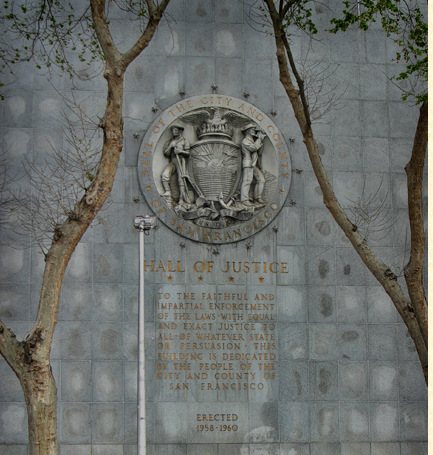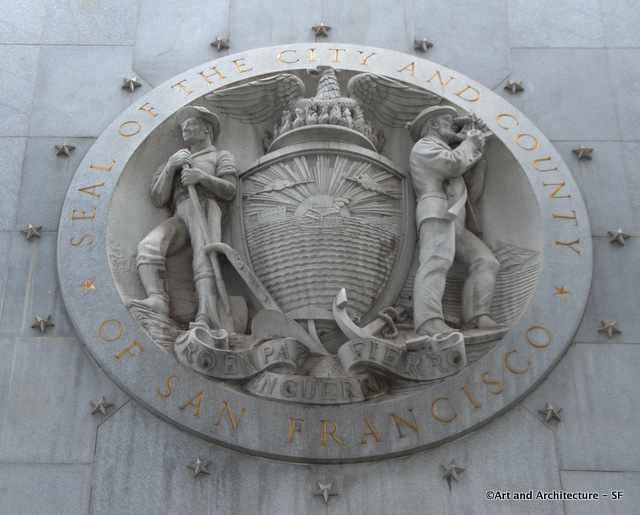465 California Street
Financial District
As you enter the lobby from the California Street side of the Merchant’s Exchange Building you will be greeted by many of San Francisco’s founders.
These ceramic/clay sculptures are each about 36″ x 24″ and were sculpted by Mark Jaeger of Marin County.
Mark was born in San Francisco and received a BA in Art Studio from UC Davis where he was influenced by Robert Arneson and Wayne Thiebaud.
Mark currently lives in Marin where he teaches full time and operates his own studio in San Anselmo.
 William Heath Davis was born in 1822, in Honolulu in the Kingdom of Hawaii to Captain William Heath Davis, Sr., a Boston ship captain and pioneer of the Hawaii sandalwood trade. Davis first visited California as a boy in 1831, then again in 1833 and 1838. The last time he joined his uncle as a store clerk in Monterey and Yerba Buena (now San Francisco). He started a business in San Francisco and became a prominent merchant and ship owner.
William Heath Davis was born in 1822, in Honolulu in the Kingdom of Hawaii to Captain William Heath Davis, Sr., a Boston ship captain and pioneer of the Hawaii sandalwood trade. Davis first visited California as a boy in 1831, then again in 1833 and 1838. The last time he joined his uncle as a store clerk in Monterey and Yerba Buena (now San Francisco). He started a business in San Francisco and became a prominent merchant and ship owner.
 Samuel Brannan (March 2, 1819 – May 5, 1889) was an American settler, businessman, journalist, and prominent Mormon who founded the California Star newspaper in San Francisco. He is considered the first publicist of the California Gold Rush and was its first millionaire.
Samuel Brannan (March 2, 1819 – May 5, 1889) was an American settler, businessman, journalist, and prominent Mormon who founded the California Star newspaper in San Francisco. He is considered the first publicist of the California Gold Rush and was its first millionaire.
 Pioneer physician in California, Dr. John Townsend and his wife came overland from Missouri in 1844 as part of the first immigrant party to cross the Sierra by way of Truckee. A founding member of the school board in San Francisco in 1847, he was elected town Alcalde (traditional Spanish municipal magistrate) in 1848. He abandoned his office at the first news of the discovery of gold, but later returned to practice medicine at a time when the new city was being swept by epidemics of dysentery and cholera. Moving to a farm near San Jose, Townsend and his wife died of cholera there at the end of 1851.
Pioneer physician in California, Dr. John Townsend and his wife came overland from Missouri in 1844 as part of the first immigrant party to cross the Sierra by way of Truckee. A founding member of the school board in San Francisco in 1847, he was elected town Alcalde (traditional Spanish municipal magistrate) in 1848. He abandoned his office at the first news of the discovery of gold, but later returned to practice medicine at a time when the new city was being swept by epidemics of dysentery and cholera. Moving to a farm near San Jose, Townsend and his wife died of cholera there at the end of 1851.

Thomas Oliver Larkin (September 16, 1802 – October 27, 1858) was an early American businessman in Alta California, and was appointed to be the United States’ first and only consul to Mexican Alta California. After the Mexican-American War ended in 1848, Larkin moved to San Francisco, and was a signer of the original California Constitution.
Others include:
John Berrien Montgomery (1794 – 25 March 1872) an officer in the United States Navy who served during the Mexican-American War and the American Civil War. On July 9, 1846, Montgomery and his detachment from the Portsmouth raised the American flag over the plaza in the town of Yerba Buena (today’s San Francisco). The name of the plaza was later changed to Portsmouth Square, commemorating Montgomery’s ship.
Jasper O’Farrell (1817–1875) was the first surveyor for San Francisco. He designed the “grand promenade” that became today’s Market Street. O’Farrell Street in San Francisco is named after him.
William Davis Merry Howard (1818–1856) was a native of Boston, Massachusetts who came to California in 1839 as a cabin boy on a sailing ship. For several years he worked on ships trading hides and tallow along the Pacific coast. In 1845 he formed the San Francisco merchant business of Mellus & Howard. Howard was one of San Francisco’s most public spirited and prosperous men at the time of the California Gold Rush.
John White Geary (December 30, 1819 – February 8, 1873) Geary was appointed postmaster of San Francisco by President James K. Polk on January 22, 1849, and on January 8 1850, he was elected the city’s alcalde, before California became a state, and then the first mayor of the city. He holds the record as the youngest mayor in San Francisco history. He was also a judge at the same time he was alcalde.





